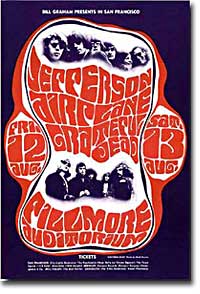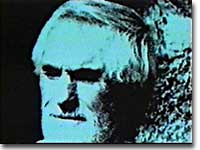57h. Flower Power
Make love, not war. Don't trust anyone over 30. Turn on, tune in, and drop out. I am a human being — please do not fold, bend spindle, or mutilate.
These and many more became slogans for emerging youth culture — a counterculture — in the 1960s. The baby boom was entering its teen years, and in sheer numbers they represented a larger force than any prior generation in the history of the United States. As more and more children of middle-class Americans entered college, many rejected the suburban conformity designed by their parents.

The Haight-Ashbury section of San Francisco gave rise to many of the popular rock groups of the era, including Jefferson Airplane and the Grateful Dead. This poster advertises a concert held at the Fillmore Auditorium, a popular San Francisco venue for psychedelic bands.
Never more than a minority movement, the so-called "hippie" lifestyle became synonymous with American youth of the 1960s. Displaying frank new attitudes about drugs and sex, communal lifestyles, and innovations in food, fashion, and music, the counterculture youth of America broke profoundly with almost all values their parents held dear.
The sexual revolution was in full swing on American college campuses. Birth control and a rejection of traditional views of sexuality led to a more casual attitude toward sex. Displays of public nudity became commonplace. Living together outside marriage shattered old norms.
In addition to changes in sexual attitudes, many youths experimented with drugs. Marijuana and LSD were used most commonly, but experimentation with mushrooms and pills was common as well. A Harvard professor named Timothy Leary made headlines by openly promoting the use of LSD. There was a price to be paid for these new attitudes. With the new freedom came an upsurge of venereal diseases, bad trips, and drug addictions.
Like the utopian societies of the 1840s, over 2000 rural communes formed during these turbulent times. Completely rejecting the capitalist system, many communes rotated duties, made their own laws, and elected their own leaders. Some were philosophically based, but others were influenced by new religions. Earth-centered religions, astrological beliefs, and Eastern faiths proliferated across American campuses. Some scholars labeled this trend as the Third Great Awakening.
Most communes, however, faced fates similar to their 19th century forebears. A charismatic leader would leave or the funds would become exhausted, and the commune would gradually dissolve.
One lasting change from the countercultural movement was in American diet. Health food stores sold wheat germ, yogurt, and granola, products completely foreign to the 1950s America. Vegetarianism became popular among many youths. Changes in fashion proved more fleeting. Long hair on young men was standard, as were Afros. Women often wore flowers in their hair. Ethnic or peasant clothing was celebrated.. Beads, bellbottom jeans, and tie-dyed shirts became the rage, as each person tried to celebrate his or her own sense of individuality.
The common bond among many youths of the time was music. Centered in the Haight-Ashbury section of San Francisco, a new wave of psychedelic rock and roll became the music of choice. Bands like the Grateful Dead, Jefferson Airplane, and the Doors created new sounds with electrically enhanced guitars, subversive lyrics, and association with drugs.

Dr. Timothy Leary — seen here in his later years — encouraged people of the 1960s to "Turn On, Tune In, and Drop Out" through the use of psychedelic drugs such as LSD.
Folk music was fused with rock, embodied by the best-known solo artist of the decade, Bob Dylan. When the popular Beatles went psychedelic with their landmark album Sgt Pepper's Lonely Hearts Club Band, counterculture music became mainstream.
It is important to note that the counterculture was probably no more than ten percent of the American youth population. Contrary to common belief, most young Americans sought careers and lifestyles similar to their parents. Young educated people actually supported the war in Vietnam in greater numbers than older, uneducated Americans. The counterculture was simply so outrageous that the media made their numbers seem larger than in reality. Nevertheless, this lifestyle made an indelible cultural impact on America for decades to come.
What happened to the ideals of the counterculture? Why weren't they able to sustain their utopian views? In part there views were subsumed by the greater culture. Moreover, it's one thing to say you want a revolution, quite another to try to affect one.





